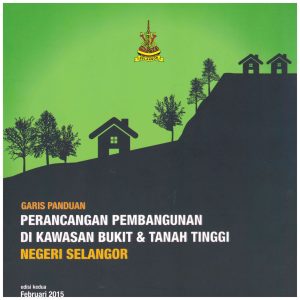In Selangor, based on Garis Panduan Pembangunan Di Kawasan Bukit dan Tanah Tinggi Negeri Selangor (2015), all slopes exceeding 25 degrees must submit planning approval.
NOTE: “In-situ” means existing slope, in its current condition.
| Slope Classification | Permitted Development | Technical Requirements |
|---|---|---|
| Class 1 - In-situ terrain with a slope < 15° - Cut slopes with a slope < 15° | Elevation of less than 300 metres above sea level: All types of development are permitted subject to: • Circulars and Instructions of the Selangor State Government • Act 172 • National Physical Plan • Selangor State Structure Plan • Structure Plan • Local Plan • Special Area Plan • Uniform Building By-Laws, 1984 • Selangor State Planning Guidelines and Standards Manual Community facilities depend on the needs and catchment area of the population. Subject to the consideration of the Technical Committee for the Development of Environmentally Sensitive Areas (KSAS) Elevation of more than 300 metres to 1000 metres above sea level: • Low-impact eco-tourism and recreational development subject to local plans, acts, regulations and relevant guidelines. • Low-impact community facilities can be considered according to the area's carrying capacity as well as the development of infrastructure and projects of interest, taking into account aspects of safety, slope maintenance, and development feasibility. Elevation of more than 1,000 metres above sea level: • No development is allowed except for the construction of infrastructure such as roads, tunnels, bridges, telecommunications, electricity of national importance with low intensity as well as projects of interest taking into account aspects of safety, slope maintenance, and feasibility of development | a. Site investigation report certified by a qualified engineer/geologist b. Stormwater Management Report in accordance with the Environmentally Friendly Drainage Manual (MASMA), 2012 prepared by a hydrological engineer registered with the Department of Irrigation and Drainage (Hydrology) c. EIA Report prepared by an EIA consultant registered with the Department of Environment for developments exceeding 50 hectares; and d. Earthworks Plan certified by an Engineer registered with the Board of Engineers Additional Requirements Other developments may be considered by the State Authority based on advice regarding: a. Comprehensive engineering planning and architectural studies. b. Using the latest environmentally friendly technology. c. Development must take into account maintenance, supervision, monitoring and enforcement. d. Developers must take out insurance or bonds to be responsible for the development being carried out. e. Consultants who carry out the above studies must be expert, credible and have appropriate experience and qualifications. f. Consideration must be given to the loading factor of development in hilly areas. |
| Class 2 - In-situ terrain with a slope of >15° to < 25° with no signs of erosion and slope instability - In-situ terrain with a slope of < 15° with signs of erosion and slope instability - In-situ terrain with a slope of < 15° formed by colluvium or sensitive geological materials - Flood hazard areas |
||
| Class 3 - In-situ terrain with a slope of > 25° to < 35° with no signs of erosion and slope instability; - In-situ terrain with a slope of > 15° to < 25° with signs of moderate to severe erosion and slope instability; - In-situ terrain with a slope of > 15° to < 25° consisting of colluvium or sensitive geological material; - In-situ terrain with a slope of < 15° consisting of colluvium or sensitive geological material with signs of slope instability; - Areas at risk of mudflows | Elevation of less than 300 metres above sea level: Permitted: • Residential • SemiD houses • Terraces • Businesses • Tourism • Training Institutions Community facilities depend on the needs and catchment area of the population. Subject to the consideration of the Technical Committee for the Development of Environmentally Sensitive Areas (KSAS) Elevation of more than 300 metres to 1000 metres above sea level: Permitted: low-impact recreation that does not involve the erection of construction structures. For example, it can be considered for camping sites and other conservation activities as well as infrastructure development and projects of interest by taking into account safety aspects, slope preservation, and development feasibility Elevation of more than 1,000 metres above sea level: No development is allowed except for the construction of infrastructure such as roads, tunnels, bridges, telecommunications, electricity of national importance with low intensity as well as projects of interest taking into account aspects of safety, slope maintenance, and feasibility of development | a. Geotechnical Investigation Report and Slope Stability Analysis certified by a certified geotechnical engineer b. Geological Mapping Report, Terrain Geology and Geomorphology prepared by a Geologist registered with the Geological Board; c. Stormwater Management Report in accordance with the Environmentally Friendly Drainage Manual (MASMA), 2012 prepared by a hydrological engineer registered with the Department of Irrigation and Hydrological Drainage; and d. Earthworks Plan prepared by an Engineer registered with the Engineers Board. e. EIA Report prepared by an EIA consultant registered with the Department of Environment for developments exceeding 50 hectares. For project development areas that have class III or IV exceeding 50% of the total project development, an Environmental Report shall be prepared subject to the recommendations of JTPKSAS. |
| Class 4 - In-situ terrain with a slope > 35° with no signs of erosion and slope instability - In-situ terrain with a slope > 25° to < 35° with signs of erosion and slope instability - In-situ terrain with a slope > 15° to < 25° consisting of colluvium or sensitive geological material with signs of slope instability - Areas with debris flow hazard - Hilltops or ridges. | Elevation of less than 300 metres above sea level: - Development involving mixed areas with class IV gradients in small areas can be developed subject to engineering solution methods and consideration by JTPKSAS Elevation of more than 300 metres to 1000 metres above sea level: - Can be considered for low-impact recreation that does not involve the erection of construction structures. For example, it can be considered for camping sites and other conservation activities as well as the development of infrastructure and projects of interest, taking into account safety aspects, slope preservation, and development feasibility Elevation of more than 1,000 metres above sea level: - No development is allowed except for the construction of infrastructure such as low-intensity roads, tunnels, bridges, telecommunications, electricity of national importance as well as projects of interest taking into account aspects of safety, slope preservation, and development feasibility | Same requirements as Class III Additional Requirements Other developments may be considered by the State Authority and should be brought to the MPFN for advice: a. Comprehensive engineering and architectural studies b. Using the latest environmentally friendly technology c. Development must take into account the maintenance of supervision, monitoring and enforcement d. Developers must take out insurance or bonds to be responsible for the development carried out e. Consultants who conduct the above studies must have expertise, credibility and have appropriate experience and qualifications f. Consideration must be given to the loading factor of development in hilly areas g. Applications submitted under the Strata Title Act 1985 (if applicable) h. Simultaneous applications (3+1) for development in sloping areas i. The design of building walls that are in contact with the slope / split level must be designed as retaining walls j. Construction of water channels / rainwater harvesting / drainage systems must be above ground and not closed (open drain). k. Natural streams / watercourses cannot be closed / filled directly unless there is a specific engineering method l. Appoint an Independent Checker as the second assessor to the appointed consultant |
| Additional requirement: Developments for sensitive areas require approval from the National Physical Planning Council (NPPC) under Section 22(2A)(c) of the Town and Country Planning Act 2001 (TCPA) | ||


